Even Martin Scorsese’s Life-Changing Bad Movie is Pretty Good
The documentary series Mr. Scorsese is too hard on the Roger Corman picture Boxcar Bertha.

The new Apple TV documentary series Mr. Scorsese contains many wonderful anecdotes and insights into the legendary filmmaker’s history. Unsurprisingly but nonetheless refreshingly, we’re reminded that Martin Scorsese didn’t arrive fully-formed, making masterpieces like Taxi Driver and The Age of Innocence right away. Rather, he had to struggle for a bit and experience his share of ups and downs.
As is often the case with biographies about the director, Mr. Scorsese locates one of those downs early in his career. Between his feature debut Who’s That Knocking at My Door and his breakout Mean Streets (his first collaboration with Robert De Niro), Scorsese agreed to make a low-budget picture for Roger Corman, king of the fast and cheap feature, called Boxcar Bertha.
According to Mr. Scorsese and other sources, Boxcar Bertha was a mistake, a deviation on Scorsese’s development. And, like most biographies, Mr. Scorsese overlooks the fact that Boxcar Bertha is actually pretty good.
Boxcar Bertha stars Barbara Hershey as Bertha Thompson, a young woman who travels across Depression-era America after the death of her father, a crop-duster pilot. Along the way, Bertha falls for anarchist labor leader Big Bill Shelly (David Carradine) and, with gambler Rake Brown (Barry Primus) and her father’s former employee Van Morton (Bernie Casey), begins robbing people. The group runs afoul of Pinkertons, the police, and especially, railroad magnate H. Buckram Sartoris (John Carradine, father of David).
Although Boxcar Bertha loosely adapts the 1937 book Sister of the Road by anarchist Ben Reitman, its true inspiration is Bonnie and Clyde, the 1967 Arthur Penn movie that kicked off the New Hollywood movement. Corman made his name by making cheap knockoffs of more popular films, and Boxcar Bertha is no exception, trying to capture the spirit of the times and the box office returns it could generate. Of course, Corman was also an incredible judge of talent, giving early shots to not just Scorsese, but also Francis Ford Coppola, Jonathan Demme, James Cameron, and others.
Thanks to that eye for talent, Corman produced cheap knock-offs could often be very good, as demonstrated by Boxcar Bertha. Scorsese gets incredible performances out of his cast, especially Hershey, whom he would later cast as Mary Magdalene in his passion project The Last Temptation of Christ. Although she’s tasked with playing a teenager (a point that makes the aggressive seduction style of grown man Shelly incredibly upsetting), Hershey gives Bertha an earnestness that never requires her to be naive.
Moreover, Boxcar Bertha includes elements that would become the defining features of Scorsese’s ouvre. No, none of the needle drops in Boxcar Bertha pack the punch of, say, “Layla” in Goodfellas, and Bertha and Big Bill are more righteous protagonists than Travis Bickle or Rupert Pupkin, but this remains a Scorsese picture. The characters live in a world dominated by violence, which can be wielded by men like Sartoris. Scorsese combines that violence with the religious longing always present in his work when Big Bill is killed by Sartoris via crucifixion.
At the end of episode two of Mr. Scorsese, Scorsese recalls what American indie icon John Cassavetes told him after watching Boxcar Bertha. According to Scorsese, Cassavetes came up to him and embraced him in a hug. “You just spent a year of your life making this piece of shit,” Scorsese recalls Cassavetes telling him; “Don’t do it again.”
Scorsese would never make another movie for Corman, nor would he ever take on another for-hire project like that. But he would do what he did in Boxcar Bertha again, making movies that are striking in their violence, sincere in their religious expression, and very, very good.
All five episodes of Mr. Scorsese are now streaming on Apple TV.
